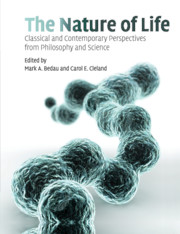Book contents
- Frontmatter
- Contents
- Preface
- Acknowledgments
- Sources
- About the authors
- Introduction
- SECTION I CLASSICAL DISCUSSIONS OF LIFE
- SECTION II THE ORIGIN AND EXTENT OF NATURAL LIFE
- SECTION III ARTIFICIAL LIFE AND SYNTHETIC BIOLOGY
- SECTION IV DEFINING AND EXPLAINING LIFE
- 23 Definitions of life
- 24 The seven pillars of life
- 25 A universal definition of life: autonomy and open-ended evolution
- 26 Does ‘life’ have a definition?
- 27 Sentient symphony
- 28 What is life?
- 29 Universal Darwinism
- 30 What is life? Was Schrödinger right?
- 31 Four puzzles about life
- Supplementary bibliography on life
- Index
- References
30 - What is life? Was Schrödinger right?
Published online by Cambridge University Press: 10 November 2010
- Frontmatter
- Contents
- Preface
- Acknowledgments
- Sources
- About the authors
- Introduction
- SECTION I CLASSICAL DISCUSSIONS OF LIFE
- SECTION II THE ORIGIN AND EXTENT OF NATURAL LIFE
- SECTION III ARTIFICIAL LIFE AND SYNTHETIC BIOLOGY
- SECTION IV DEFINING AND EXPLAINING LIFE
- 23 Definitions of life
- 24 The seven pillars of life
- 25 A universal definition of life: autonomy and open-ended evolution
- 26 Does ‘life’ have a definition?
- 27 Sentient symphony
- 28 What is life?
- 29 Universal Darwinism
- 30 What is life? Was Schrödinger right?
- 31 Four puzzles about life
- Supplementary bibliography on life
- Index
- References
Summary
In Dublin half a century ago, a major figure in this century's science visited, lectured, and foretold the future of a science which was not his own. The resulting book, What is Life?, is credited with having inspired some of the most brilliant minds ever to enter biology to the work which gave birth to molecular biology (Schrödinger 1967). Schrödinger's “little book” is, itself, as brilliant as warranted by its reputation. But, half a century later, and at the occasion of its honouring, perhaps we may dare to ask a new question: is the central thesis of the book right? I mean no dishonour to so superb a mind as Schrödinger's, nor to those properly inspired by him, to suggest that he may have been wrong, or at least incomplete. Rather, of course, like all scientists inspired by his ideas, I too seek to continue the quest.
I am hesitant even to raise the questions I shall raise, for I am also fully aware of how deeply embedded Schrödinger's own answers are in our view of life since Darwin and Weismann, and since the development of the theory of the germ plasma, with the gene as the necessary stable storage form of heritable variation: “Order from order,” answered Schrödinger. The large aperiodic solids and the microcode of which Schrödinger spoke have become the DNA and the genetic code of today. Almost all biologists are convinced that such self-replicating molecular structures and such a microcode are essential to life.
- Type
- Chapter
- Information
- The Nature of LifeClassical and Contemporary Perspectives from Philosophy and Science, pp. 374 - 391Publisher: Cambridge University PressPrint publication year: 2010



